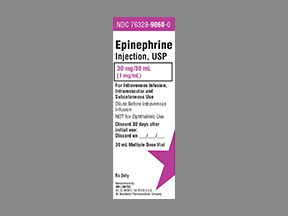
Epinephrine (anaphylaxis) Coupons & Savings Card – Discount Prices from $68.49
Generic for: Adrenalin
My prescription
Edit
30ML of 30MG/30ML, Epinephrine (anaphylaxis) (1 Vial)
Select pharmacy

CVS
$207.68
COUPON PRICE
Walgreens
$68.49
COUPON PRICE
Albertsons
$77.00
COUPON PRICE
Walmart
$211.01
COUPON PRICEEpinephrine (anaphylaxis) savings card
Show this card to your pharmacist
Walgreens
$68.49
BIN
ID
PCN
GRP
015995
LHFC695892
GDC
GDRX
Powered by
More prescriptions for septic shock
More prescriptions for septic shock
Price history for Adrenalin (brand) & Epinephrine (anaphylaxis) (generic)
1 Vial, 30ML of 30MG/30ML
Average retail price for Adrenalin
Average retail price for Epinephrine (anaphylaxis)
Average SaveHealth price for Epinephrine (anaphylaxis)
Our price history data is based on aggregated prescription data collected from participating pharmacies in America. Our prescription data updates daily to reflect the latest price changes. If you notice a missing data point, it means there wasn't sufficient data available to generate a monetary value for that date.
We analyzed Epinephrine (anaphylaxis) prices for (30ML of 30MG/30ML, 1 Vial) over the last 12 months. The average retail price was $679.33, while the average price using the SaveHealth discount card was $160.95. That's a savings of approximately 76.31% when using our Epinephrine (anaphylaxis) coupon.
Compared to the generic version, Adrenalin had an average price of $304.70 over the same time period. With the SaveHealth savings card, Epinephrine (anaphylaxis) is 47.18% cheaper on average than Adrenalin.
*Retail prices are based on pharmacy claims data, and may not be accurate when we don't have enough claims.
Epinephrine (anaphylaxis) dosage forms
Dosage Quantity Price from Per unit 30ML of 30MG/30ML 1 Vial $156.30 $156.30 30ML of 30MG/30ML 2 Vials $303.60 $151.80 30ML of 30MG/30ML 3 Vials $450.90 $150.30
| Dosage | Quantity | Price from | Per unit |
|---|---|---|---|
| 30ML of 30MG/30ML | 1 Vial | $156.30 | $156.30 |
| 30ML of 30MG/30ML | 2 Vials | $303.60 | $151.80 |
| 30ML of 30MG/30ML | 3 Vials | $450.90 | $150.30 |
Epinephrine (anaphylaxis) Warnings
Epinephrine is a critical medication for treating anaphylaxis, a severe allergic reaction. While it is generally safe and effective, certain risks are associated with its use, particularly when not administered correctly.
Injection Site Risks: Epinephrine should be injected into the outer thigh muscle. Injecting it into other areas, such as the buttocks, hands, or feet, can lead to reduced effectiveness and may cause tissue damage due to restricted blood flow. Accidental injection into fingers or toes can result in decreased blood circulation to these areas, potentially leading to tissue damage. If an accidental injection occurs, seek immediate medical attention.
Cardiovascular Concerns: Epinephrine can increase heart rate and blood pressure. Individuals with heart conditions, such as arrhythmias or coronary artery disease, should use epinephrine with caution, as it may exacerbate these conditions. However, in life-threatening anaphylactic situations, the benefits of administering epinephrine generally outweigh the risks.
Allergic Reactions to Preservatives: Some epinephrine formulations contain sodium metabisulfite, a preservative that can cause allergic reactions in sensitive individuals. Despite this, epinephrine remains the preferred treatment for severe allergic reactions, as the benefits typically outweigh the risks associated with sulfite sensitivity.
Storage and Handling: Proper storage of epinephrine auto-injectors is essential. They should be kept at room temperature and protected from light. Exposure to extreme temperatures can reduce the medication's effectiveness. Regularly check the expiration date and replace the auto-injector as needed to ensure it functions correctly when required.
Proper Training and Use: Misuse of epinephrine auto-injectors can lead to injuries or inadequate treatment. It's important for patients and caregivers to receive proper training on the correct use of the device. Regular practice with a trainer device can help ensure confidence and accuracy during an emergency.
In summary, while epinephrine is a life-saving treatment for anaphylaxis, awareness of these risks and proper usage are crucial to maximize its benefits and minimize potential complications.
Epinephrine (anaphylaxis) Side Effects
Epinephrine is the primary treatment for anaphylaxis, a severe allergic reaction. While it is highly effective in reversing life-threatening symptoms, its use can lead to certain side effects. Common side effects include anxiety, restlessness, dizziness, shakiness, headache, sweating, paleness, nausea, vomiting, and a rapid or pounding heartbeat. These effects are typically mild and transient, resolving within a few minutes to hours. In rare instances, more serious side effects may occur, such as abnormal heart rhythms, chest pain, significant increases in blood pressure, or difficulty breathing. Individuals with pre-existing heart conditions, high blood pressure, or hyperthyroidism may have a higher risk of experiencing these adverse effects. Despite these potential side effects, the benefits of administering epinephrine during an anaphylactic reaction far outweigh the risks. Prompt use of epinephrine can be life-saving, and delaying treatment due to concerns about side effects is not recommended. After using epinephrine, it is crucial to seek immediate medical attention, as further monitoring and treatment may be necessary. Always inform healthcare providers about the administration of epinephrine and any side effects experienced.
Epinephrine (anaphylaxis) Interactions
Epinephrine is the primary treatment for anaphylaxis, a severe allergic reaction. However, certain medications can interact with epinephrine, potentially affecting its effectiveness or increasing the risk of side effects. It's important to be aware of these interactions:
Beta-Blockers: Commonly prescribed for high blood pressure and heart conditions, beta-blockers may reduce the effectiveness of epinephrine. In some cases, they can also increase the risk of severe allergic reactions.
Tricyclic Antidepressants (TCAs): Used to treat depression and certain types of pain, TCAs can enhance the effects of epinephrine, potentially leading to elevated blood pressure and heart rate.
Monoamine Oxidase Inhibitors (MAOIs): These antidepressants can prolong the action of epinephrine, increasing the risk of side effects such as high blood pressure and irregular heart rhythms.
Alpha-Blockers: Medications like Phentolamine, used to treat high blood pressure, can counteract the blood vessel-constricting effects of epinephrine, potentially reducing its effectiveness during anaphylaxis.
Diuretics: Often used to manage high blood pressure and fluid retention, diuretics may diminish the pressor effects of epinephrine and increase the risk of irregular heart rhythms.
Antihistamines and Thyroid Hormones: These can potentiate the arrhythmogenic effects of epinephrine, increasing the risk of heart rhythm disturbances.
Despite these potential interactions, epinephrine remains the most effective treatment for anaphylaxis. In emergency situations, the benefits of administering epinephrine typically outweigh the risks associated with these drug interactions. However, individuals taking these medications should consult their healthcare provider to discuss their specific risks and to develop a comprehensive anaphylaxis management plan.
